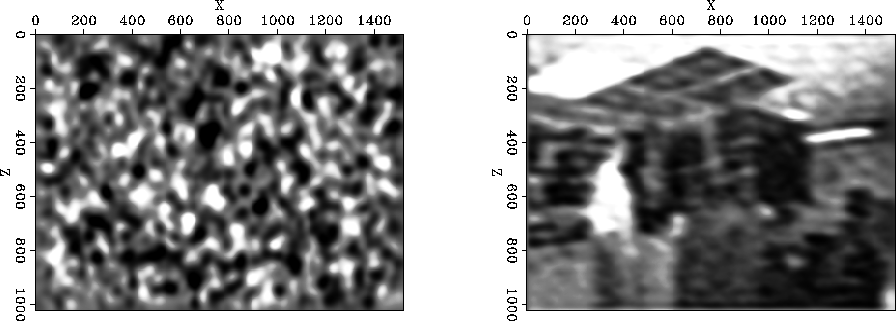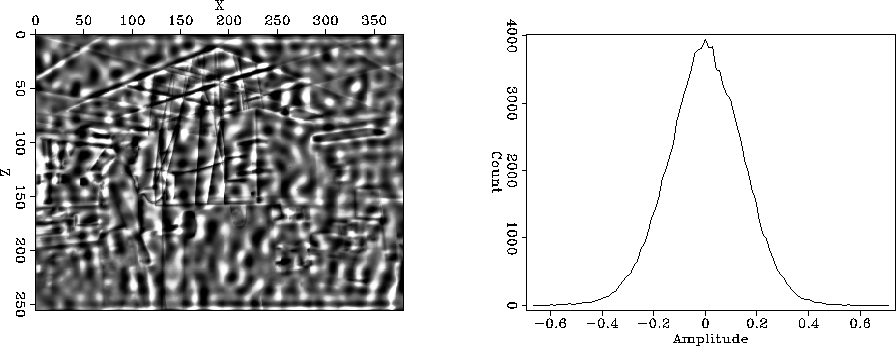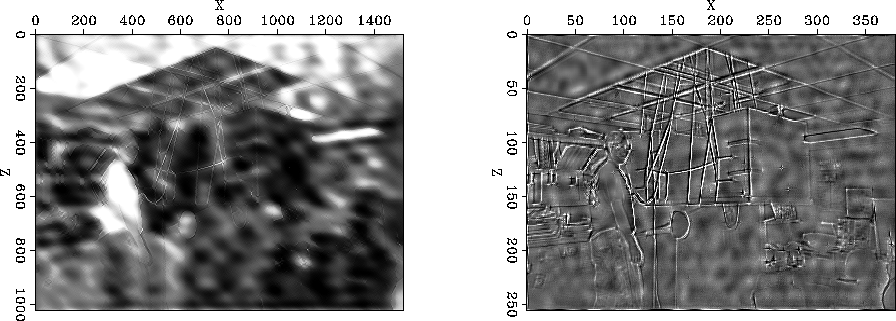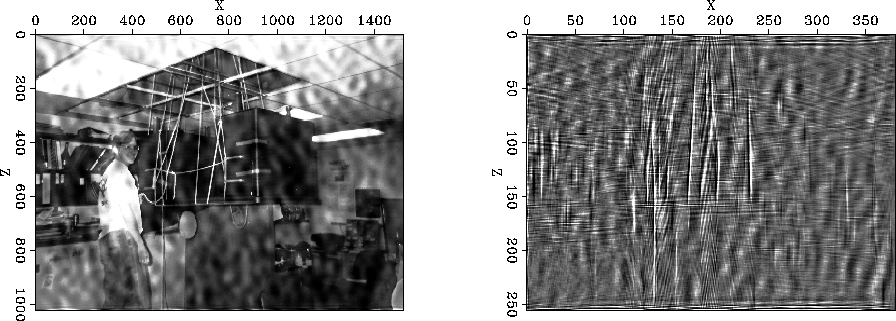




Next: Types of noise
Up: PROBLEMS
Previous: PROBLEMS
A more difficult,
but at times more realistic, challenge is when our noise is not
Gaussian. The left panel of Figure ![[*]](http://sepwww.stanford.edu/latex2html/cross_ref_motif.gif) shows smoothed
Gaussian noise, of approximately
the same amplitude as the random noise
used above, that we will add to our data (right panel of
Figure
shows smoothed
Gaussian noise, of approximately
the same amplitude as the random noise
used above, that we will add to our data (right panel of
Figure ![[*]](http://sepwww.stanford.edu/latex2html/cross_ref_motif.gif) ). The resulting model estimate
(right panel of Figure
). The resulting model estimate
(right panel of Figure ![[*]](http://sepwww.stanford.edu/latex2html/cross_ref_motif.gif) ) shows a clear imprint
of the noise pattern.
If we look at the
) shows a clear imprint
of the noise pattern.
If we look at the  vector (left panel of
Figure
vector (left panel of
Figure ![[*]](http://sepwww.stanford.edu/latex2html/cross_ref_motif.gif) ),
we see that we have disobeyed
both of the IID requirements. The residual is definitely
correlated and if we look at histogram of the residuals (right
panel of Figure
),
we see that we have disobeyed
both of the IID requirements. The residual is definitely
correlated and if we look at histogram of the residuals (right
panel of Figure ![[*]](http://sepwww.stanford.edu/latex2html/cross_ref_motif.gif) ), the identically distributed
requirement looks suspect.
iid
), the identically distributed
requirement looks suspect.
iid
Figure 6 The left panel shows
correlated noise that we are going to add to our data.
The right panel shows the resulting inversion. Note
how the imprint of the noise is visible in the model.
![[*]](http://sepwww.stanford.edu/latex2html/movie.gif)




 iid2
iid2
Figure 7 The left panel shows the residual ( )associated with the model in Figure
)associated with the model in Figure ![[*]](http://sepwww.stanford.edu/latex2html/cross_ref_motif.gif) .
The right panel is a histogram of the residual.
Note the structure in the residual and the deviation
from Gaussian of the residual.
.
The right panel is a histogram of the residual.
Note the structure in the residual and the deviation
from Gaussian of the residual.
![[*]](http://sepwww.stanford.edu/latex2html/movie.gif)





Up to this point we have ignored the
inverse noise covariance matrix  . Claerbout (1999)
and Guitton (2000) suggested
using a PEF for
. Claerbout (1999)
and Guitton (2000) suggested
using a PEF for  estimated from the residual.
If we do this we get an improved result (left panel
of Figure
estimated from the residual.
If we do this we get an improved result (left panel
of Figure ![[*]](http://sepwww.stanford.edu/latex2html/cross_ref_motif.gif) ) and a more decorrellate residual
(right panel of Figure
) and a more decorrellate residual
(right panel of Figure ![[*]](http://sepwww.stanford.edu/latex2html/cross_ref_motif.gif) ).
Remember that
).
Remember that  should
be the inverse of the noise spectrum. Estimating
it from the residual does not necessarily give
us the same information.
Since this is a synthetic example, we have another
option. We can estimate
should
be the inverse of the noise spectrum. Estimating
it from the residual does not necessarily give
us the same information.
Since this is a synthetic example, we have another
option. We can estimate  directly
from our noise estimate. Figure
directly
from our noise estimate. Figure ![[*]](http://sepwww.stanford.edu/latex2html/cross_ref_motif.gif) shows
the result of the inversion using this filter and
the
shows
the result of the inversion using this filter and
the  vector associated with
the inversion.
The resulting estimate is generally of higher quality.
vector associated with
the inversion.
The resulting estimate is generally of higher quality.
iid3
Figure 8 The left panel shows the inversion result
using a PEF estimated from the residual as  .The right panel shows the resulting
.The right panel shows the resulting  . Note
the improved result compared to Figure
. Note
the improved result compared to Figure ![[*]](http://sepwww.stanford.edu/latex2html/cross_ref_motif.gif) .
.
![[*]](http://sepwww.stanford.edu/latex2html/movie.gif)





iid4
Figure 9 The left panel shows the inversion result
using a PEF estimated from the known noise as  .The right panel shows the resulting
.The right panel shows the resulting  . Note
the improved result compared to Figure
. Note
the improved result compared to Figure ![[*]](http://sepwww.stanford.edu/latex2html/cross_ref_motif.gif) .
Compared to Figure
.
Compared to Figure ![[*]](http://sepwww.stanford.edu/latex2html/cross_ref_motif.gif) we see an improvement
in image clarity at some expense of a boosting of the noise.
we see an improvement
in image clarity at some expense of a boosting of the noise.
![[*]](http://sepwww.stanford.edu/latex2html/movie.gif)










Next: Types of noise
Up: PROBLEMS
Previous: PROBLEMS
Stanford Exploration Project
7/8/2003

![[*]](http://sepwww.stanford.edu/latex2html/movie.gif)
![[*]](http://sepwww.stanford.edu/latex2html/cross_ref_motif.gif) shows smoothed
Gaussian noise, of approximately
the same amplitude as the random noise
used above, that we will add to our data (right panel of
Figure
shows smoothed
Gaussian noise, of approximately
the same amplitude as the random noise
used above, that we will add to our data (right panel of
Figure ![[*]](http://sepwww.stanford.edu/latex2html/cross_ref_motif.gif) ). The resulting model estimate
(right panel of Figure
). The resulting model estimate
(right panel of Figure ![[*]](http://sepwww.stanford.edu/latex2html/cross_ref_motif.gif) ) shows a clear imprint
of the noise pattern.
If we look at the
) shows a clear imprint
of the noise pattern.
If we look at the ![[*]](http://sepwww.stanford.edu/latex2html/cross_ref_motif.gif) ),
we see that we have disobeyed
both of the IID requirements. The residual is definitely
correlated and if we look at histogram of the residuals (right
panel of Figure
),
we see that we have disobeyed
both of the IID requirements. The residual is definitely
correlated and if we look at histogram of the residuals (right
panel of Figure ![[*]](http://sepwww.stanford.edu/latex2html/cross_ref_motif.gif) ), the identically distributed
requirement looks suspect.
), the identically distributed
requirement looks suspect.

![[*]](http://sepwww.stanford.edu/latex2html/movie.gif)

![[*]](http://sepwww.stanford.edu/latex2html/cross_ref_motif.gif) .
The right panel is a histogram of the residual.
Note the structure in the residual and the deviation
from Gaussian of the residual.
.
The right panel is a histogram of the residual.
Note the structure in the residual and the deviation
from Gaussian of the residual.
![[*]](http://sepwww.stanford.edu/latex2html/movie.gif)
![]() . Claerbout (1999)
and Guitton (2000) suggested
using a PEF for
. Claerbout (1999)
and Guitton (2000) suggested
using a PEF for ![]() estimated from the residual.
If we do this we get an improved result (left panel
of Figure
estimated from the residual.
If we do this we get an improved result (left panel
of Figure ![[*]](http://sepwww.stanford.edu/latex2html/cross_ref_motif.gif) ) and a more decorrellate residual
(right panel of Figure
) and a more decorrellate residual
(right panel of Figure ![[*]](http://sepwww.stanford.edu/latex2html/cross_ref_motif.gif) ).
Remember that
).
Remember that ![]() should
be the inverse of the noise spectrum. Estimating
it from the residual does not necessarily give
us the same information.
Since this is a synthetic example, we have another
option. We can estimate
should
be the inverse of the noise spectrum. Estimating
it from the residual does not necessarily give
us the same information.
Since this is a synthetic example, we have another
option. We can estimate ![]() directly
from our noise estimate. Figure
directly
from our noise estimate. Figure ![[*]](http://sepwww.stanford.edu/latex2html/cross_ref_motif.gif) shows
the result of the inversion using this filter and
the
shows
the result of the inversion using this filter and
the ![]() vector associated with
the inversion.
The resulting estimate is generally of higher quality.
vector associated with
the inversion.
The resulting estimate is generally of higher quality.

![[*]](http://sepwww.stanford.edu/latex2html/cross_ref_motif.gif) .
.

![[*]](http://sepwww.stanford.edu/latex2html/cross_ref_motif.gif) .
Compared to Figure
.
Compared to Figure ![[*]](http://sepwww.stanford.edu/latex2html/cross_ref_motif.gif) we see an improvement
in image clarity at some expense of a boosting of the noise.
we see an improvement
in image clarity at some expense of a boosting of the noise.
![[*]](http://sepwww.stanford.edu/latex2html/movie.gif)